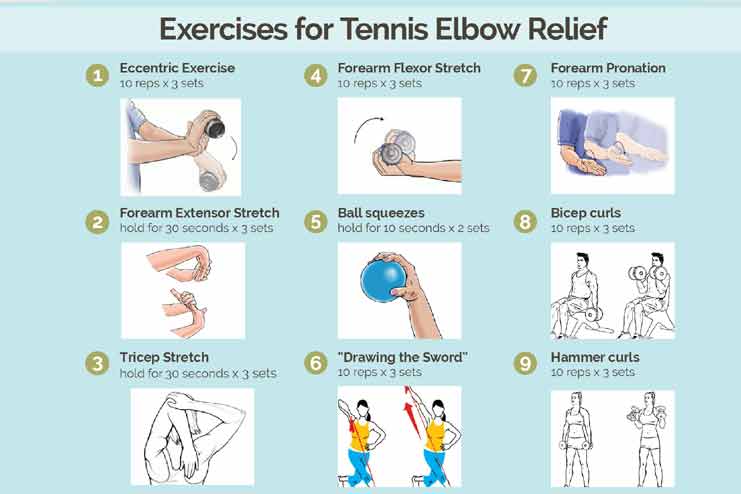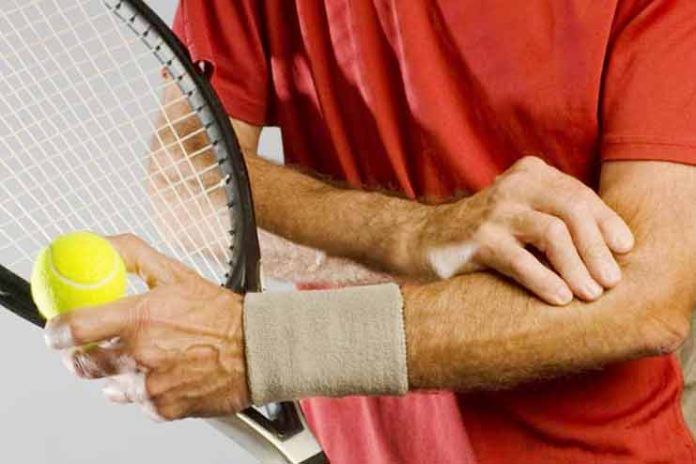Affiliate Disclaimer
Some links in this article are affiliate links. We may earn a small commission if you make a purchase through these links, at no extra cost to you. We only recommend products we find useful to our readersTennis elbow, heard of it? The term is known to many even though a very few people were diagnosed with it. As the names suggests, it is an injury that may be caused due to playing tennis. In medical terms, it is called as lateral epicondylitis. Tennis elbow is not a serious injury type, but requires time and rest to get healed.
Is It Painful?
Yes, Tennis elbow is a pain focused on the area where the forearm meets your elbow. The pain concentrates on the outer layer and is due to disturbance in muscle and tendons in the forearm.
The problem arises due to constant use or repetitive motion of arm, because of which the tendons at the elbow end of the extensor carpi radialis brevis (ECRB) muscle may develop tears. These tears cause inflammation and stress on the remaining arm, hence making it painful to lift things. It turns chronic, if left untreated.
Main Causes For Tennis Elbow:
The condition is mainly caused due to overuse of the arm and elbow. As tennis is a game of repeated strokes, the chances for tennis elbow are fairly higher. Also, poor technique or racquet grip create pressure on the tendons, leading to tennis elbow. However, only less than 5% cases are related to tennis. Other racquet sports, such as racquetball or squash are also related to this health condition.
Activities or jobs involving repetitive arm motion also cause tennis elbow. They include:
- Painting
- Tree-cutting
- Carpentry
- Playing some musical
- Repetitive computer mouse use
Also, cooks, butchers, and assembly-line workers are among those who often suffer tennis elbow.
Note: Tennis elbow is different from Golfer’s elbow even though tendon tears are caused by repetitive movements of the hands. Because, the pain in Golfer’s elbow is focused on the inside of the elbow.
Risk Factors That Increase Your Risk Of Tennis Elbow Include:
Age: Tennis elbow is common in adults between 30 and 50 years of age.
However, it can occur in people of any age group.
Occupation: As mentioned earlier, people working in occupations that involve more of arm and wrist are likely to develop tennis elbow.
Certain sports. Sports people involved in racket usage increases the risk of tennis elbow.
Symptoms Of Tennis Elbow
The ache on the outside of the elbow is the major symptom of tennis elbow, which may affect both the arms.
The ache may turn into a chronic pain over time.
Eventually, it may become difficult even to lift things.
Pain and weakness may make it difficult even to shake hands, turn a door knob, or even hold a coffee cup.
Diagnosis Of Tennis Elbow
Physician conducts physical examination to check for the symptoms of Tennis Elbow. Simple actions like straightening your wrist against pressure and so on may be asked to do. In most cases medical history and the physical examination are enough to diagnose this medical condition. However, the doctor may further ask to go for X-ray or imaging tests like MRI scan.
Treatment For Tennis Elbow
Tennis elbow can be treated effectively with simple lifestyle changes along with medical aid. They include:
- Physical therapy: The therapist helps gradually stretch and strengthen muscles, especially of the forearm. Eccentric exercises help big time, as they involve lowering and raising the wrist very slowly. The doctor may suggest the brace or the forearm strap to reduce stress on the injured tissue.
- Medications as prescribed by the doctor including aspirin, ibuprofen, Motrin, Advil. Over the counter pills may also offer pain relief.
- Surgical or other procedures: (i) Injections: To control the pain, the doctor might suggest injecting platelet-rich plasma, Botox or some irritant (prolotherapy) into the painful tendon. Dry needling can also help, which is nothing but piercing needles at the damaged tendon in many places. (ii) Ultrasonic tenotomy (TENEX procedure): It is a medical procedure that involves inserting a special needle through the skin under ultrasound guidance into the damaged portion of the tendon. The needle is vibrated swiftly by the ultrasonic energy for the damaged tissue to get liquefied and can be suctioned out. (iii) Surgery: Even after the 6 to 12 months treatment if the pain does not subside, a surgery may become the option for the removal of the damaged tissue. Such procedures can be performed through several small incisions or a large incision. Rehabilitation exercises play a prominent role in recovery.
- Lifestyle and home remedies: Rest so that the elbow pain doesn’t exaggerate. Expert-evaluation to analyze the tennis techniques and movements to correct and take right measures to reduce the stress on the injured tissues. Self-care measures like applying ice bags or a cold pack for 15 minutes at least thrice a day will be helpful.
- Exercising as per the expert guidance.
What Are The Strengthening Exercises For Tennis Elbow:
Strengthening exercises for Tennis elbow are listed below.


Ball or sock squeeze:
- Hold tennis ball in your hand.
- Make a fist and squeeze.
- Hold for 6 seconds and release.
- Repeat 10 times a day. Repeat in both the hands.
Wrist deviation
- Sit by resting your arm on a flat surface and leaving your hand hanging off the edge.
- Move your hand up and down. Keep repeating the motion for 8 to 12 times.
- Repeat by switching arms.
Wrist Curl exercises
- Sit placing your forearm on a table, palm up, and hand hanging over the edge.
- Place an object that weighs around 1 to 2 pounds in your hand.
- Slowing keep raising and rest forearm on the table.
- Keep repeating the motion for 8 to 12 times. Switch arms.
Bicep curls
- Lean forward and sit with legs spread little.
- Place your left hand on your left thigh. Right hand on the right thigh.
- Hold weight with your forearm. Curl the weight slowly toward the chest.
- Keep repeating the motion for 8 to 12 times. Switch arms.
Overview
Tennis elbow or lateral epicondylitis is a painful condition that occurs due to overuse and muscle strain injury.
Occurs when elbow tendons are overloaded due to repetitive motions of arm and the wrist.
Over-the-counter pain relievers and enough rest help relieve tennis elbow. Surgery may be a last option if all the conservative treatments fail or if the symptoms are disabling.































